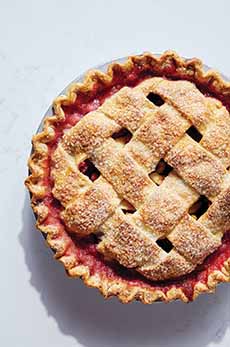|
Spring is rhubarb season. Fresh rhubarb is available for just three months a year, so do something special with it. A few ideas:
Stewed rhubarb or rhubarb compote, delicious as a side with ham, pork and poultry
Rhubarb ice cream
Rhubarb tarts, crisps and other baked goods (substitute rhubarb for apples or pears in your favorite recipes)
Rhubarb pickles
Technically, rhubarb is a vegetable, a member of the sorrel family. Before it was sweetened by British cooks, it was added to soups (try it in lentil soup), sauces and stews—Moroccan tagines and Middle Eastern stews, for example. Be sure to cook only the stems; the leaves are mildly toxic.
For Easter, how about a strawberry-rhubarb pie or raspberry-rhubarb pie. Here’s a recipe.
LATTICE PIE CRUST
Make your Easter pie extra-special with a lattice crust. The top crust of any fruit pie can be replaced with a lattice crust.
Apple and pear pies need a tight lattice so the fruit doesn’t dry out. You can use a loose lattice (more space between the strips of dough) when baking berry, cherry, rhubarb and stone fruit pies, because the fruits have more moisture.
Here’s a lattice tip from Lauren Chattman, author of The Baking Answer Book:
Instead of weaving the lattice on top of the filled pie, start with a cardboard cake circle set atop a baking sheet.
Cut the dough into 13-inch strips and weave the lattice on the cardboard.
Place the baking sheet in the freezer for 15 minutes to firm up the lattice.
Slip the lattice from the cardboard onto the pie.
Adjust the lattice strips to make them even, if required. Trim the ends and crimp onto the pie plate. Bake.
|
|

[1] Strawberry-rhubarb pie with a lattice crust. These lattice strips are very wide and quicker to weave, but are not as elegant as the thin strips in the photo below (photos #1 and #2 © King Arthur Flour).

[2] Lattice strips can be much thinner, and can be cut with a crimped dough cutter.
|




